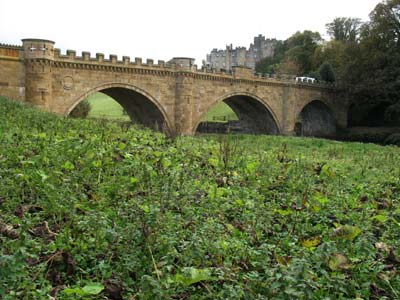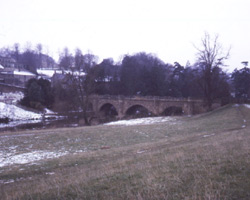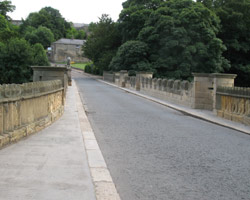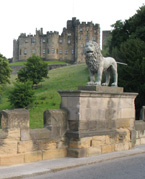
LION BRIDGE

"I remember the Percy lion on the bridge over the little river at Alnwick - the leaden lion with its tail outstretched like a pump handle - and why? Because of the story of the village boy who would fain bestride the leaden tail, standing out over the water, which breaking, he dropped it into the stream far below, and was taken out an idiot for the rest of his life".
The Autocrat of the Breakfast-Table. Oliver Wendell Holmes. 1858.
The most famous bridge on the Aln is the Lion Bridge. It was built by John Adam for the first Duke of Northumberland and is an early example of Gothic Revival style. The bridge is built of squared sandstone blocks with ashlar dressing and comprises three semi-circular arches supported on piers with cutwaters and splayed abutments. Castellated parapets are intersected at the centre with molded pedestals. The Percy Lion of cast lead sculpted by John Knowles stands in the centre of the parapet on the downstream parapet. It was restored in 1994 after being knocked into the river by a fairground wagon crossing the bridge. Floods in 2008 damaged the bridge and it was closed for a time while repairs were carried out and preventive measures taken to prevent pier damage in any future scouring.
It was once known as simply the Alnwick Bridge and replaced an earlier medieval bridge (which may have been 100 feet downstream of the present one), destroyed by flood. It links the town on the south river bank to the north on the B6341 road, with a link to the A1 too. The two outer arches have spans of 40 feet while the centre span is 50 feet and the height of the arches is 15 feet. The parapets are provided with four pedestrian refuges and cutwaters protect the bridge on the upstream side. It is Grade 1 listed.
Looking southeast from the bridge is a magnificent view of Alnwick Castle and the Pastures. To the west the land is more wooded. The bridge is mentioned by Oliver Wendell Holmes, the American physician and author in his book 'The Autocrat of the Breakfast-Table'.
- Constructed - 1773
- Type - three arches (plus two buried arches), stone.
- Position: Alnwick, Northumberland.
- Grid Ref: NU 186 138



